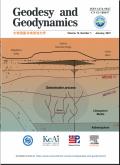线性结构加权总最小二乘问题的算法与统计分析
IF 2.8
4区 地球科学
Q2 GEOCHEMISTRY & GEOPHYSICS
引用次数: 0
摘要
加权总最小二乘(WTLS)被认为是处理观测向量和系数矩阵中所有元素都带有随机误差的变量误差(EIV)模型的标准工具。然而,在许多大地测量应用中,一些元素是无误差的,一些随机观测值在增广系数矩阵的不同位置重复出现。它被称为线性结构化EIV (LSEIV)模型。针对LSEIV模型提出了两种方法,分别从泛函修正和随机修正两方面进行了改进。一方面,将LSEIV模型的功能部分修改为观测误差(EIO)模型;另一方面,利用协因子矩阵的Moore-Penrose逆对随机模型进行修正。算法是通过拉格朗日乘子法和线性逼近推导出来的。证明了参数的估计原理和迭代公式是一致的。导出了参数的一阶近似方差-协方差矩阵(VCM)。最后通过一个算例比较了本文提出的三种算法与STLS方法的性能。然后,比较了最小二乘(LS)、总最小二乘(TLS)和线性结构加权总最小二乘(LSWTLS)三种解,证明了精度评价公式的可行性和有效性。最后,将LSWTLS应用于变形分析领域,得到了比传统LS和TLS估计更好的结果。本文章由计算机程序翻译,如有差异,请以英文原文为准。
Algorithms and statistical analysis for linear structured weighted total least squares problem
Weighted total least squares (WTLS) have been regarded as the standard tool for the errors-in-variables (EIV) model in which all the elements in the observation vector and the coefficient matrix are contaminated with random errors. However, in many geodetic applications, some elements are error-free and some random observations appear repeatedly in different positions in the augmented coefficient matrix. It is called the linear structured EIV (LSEIV) model. Two kinds of methods are proposed for the LSEIV model from functional and stochastic modifications. On the one hand, the functional part of the LSEIV model is modified into the errors-in-observations (EIO) model. On the other hand, the stochastic model is modified by applying the Moore-Penrose inverse of the cofactor matrix. The algorithms are derived through the Lagrange multipliers method and linear approximation. The estimation principles and iterative formula of the parameters are proven to be consistent. The first-order approximate variance-covariance matrix (VCM) of the parameters is also derived. A numerical example is given to compare the performances of our proposed three algorithms with the STLS approach. Afterwards, the least squares (LS), total least squares (TLS) and linear structured weighted total least squares (LSWTLS) solutions are compared and the accuracy evaluation formula is proven to be feasible and effective. Finally, the LSWTLS is applied to the field of deformation analysis, which yields a better result than the traditional LS and TLS estimations.
求助全文
通过发布文献求助,成功后即可免费获取论文全文。
去求助
来源期刊

Geodesy and Geodynamics
GEOCHEMISTRY & GEOPHYSICS-
CiteScore
4.40
自引率
4.20%
发文量
566
审稿时长
69 days
期刊介绍:
Geodesy and Geodynamics launched in October, 2010, and is a bimonthly publication. It is sponsored jointly by Institute of Seismology, China Earthquake Administration, Science Press, and another six agencies. It is an international journal with a Chinese heart. Geodesy and Geodynamics is committed to the publication of quality scientific papers in English in the fields of geodesy and geodynamics from authors around the world. Its aim is to promote a combination between Geodesy and Geodynamics, deepen the application of Geodesy in the field of Geoscience and quicken worldwide fellows'' understanding on scientific research activity in China. It mainly publishes newest research achievements in the field of Geodesy, Geodynamics, Science of Disaster and so on. Aims and Scope: new theories and methods of geodesy; new results of monitoring and studying crustal movement and deformation by using geodetic theories and methods; new ways and achievements in earthquake-prediction investigation by using geodetic theories and methods; new results of crustal movement and deformation studies by using other geologic, hydrological, and geophysical theories and methods; new results of satellite gravity measurements; new development and results of space-to-ground observation technology.
 求助内容:
求助内容: 应助结果提醒方式:
应助结果提醒方式:


